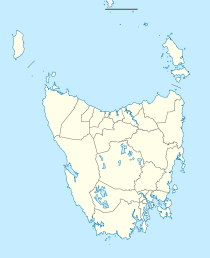Deddington, Tasmania facts for kids
Quick facts for kids DeddingtonTasmania |
|||||||||||||||
|---|---|---|---|---|---|---|---|---|---|---|---|---|---|---|---|
| Population | 121 (2016 census) | ||||||||||||||
| Postcode(s) | 7212 | ||||||||||||||
| Elevation | 245 m (804 ft) | ||||||||||||||
| Location |
|
||||||||||||||
| LGA(s) | Northern Midlands | ||||||||||||||
| Region | Central | ||||||||||||||
| State electorate(s) | Lyons | ||||||||||||||
| Federal Division(s) | Lyons | ||||||||||||||
|
|||||||||||||||
Deddington is a small rural area in Tasmania, Australia. It is part of the Northern Midlands region.
This area is about 34 kilometers (21 miles) east of the town of Longford. According to the 2016 census, 121 people live in Deddington. The town is located by the Nile River, nestled in the foothills of Ben Lomond mountain.
Contents
History
Who lived here first?
The first people to live in the Deddington area were Tasmanian Aboriginal people. They were part of the Ben Lomond Nation. They used the land for hunting and had seasonal camps along the Nile River and Patterdale Creek.
Aboriginal tools and other items have been found here. These show how they used the land for a very long time. The Aboriginal name for the Nile River at Deddington was witakina. This area was important for hunting. It was also part of the travel routes for different Aboriginal groups.
Early European Settlers
European settlers started getting land in the Deddington area in the early 1800s. People like James Cox, Anthony Cottrell, and Massey received land grants. Before the main settlers arrived, stockkeepers and timber-cutters often moved into the area. These were often convicts assigned to landowners.
At first, Aboriginal people and assigned men sometimes traded goods. However, as more settlers arrived, conflicts began to happen. There were disputes over land and resources. This led to a period of violence known as the Black War. By the 1840s, the Aboriginal people of the Ben Lomond nation had been moved to Flinders Island.
Growing as a Town
By the 1840s, there were enough settlers in Deddington for a chapel to be built. This chapel was located above the Nile River. Local stories say that the famous artist John Glover helped build it. John Glover is buried in the cemetery there.
More services came to the town starting in the 1860s. The Deddington Post Office opened on December 1, 1862. It stayed open until 1970. A school also opened in Deddington in early 1865. A teacher was hired to teach the local children.
By the middle of 1866, land was set aside for a police station. A police officer was then stationed in the town permanently. Around the same time, the Deddington Inn opened in December 1866. In 1882, a newspaper reported that Deddington had an inn, a store, a blacksmith shop, a post office, and about a dozen other buildings.
Changes Over Time
By 1980, the town center had become much quieter. The post office, school, and shop had all closed down. The Deddington Inn burned down in 1980. Today, the nearby town of Evandale provides most services for Deddington. Deddington was officially named a locality in 1959.
Geography
The Nile River flows through Deddington from east to west. This river is a branch of the larger South Esk River.
Road Infrastructure
Route C420, also known as Deddington Road, runs through the area. It connects Deddington from the north to the west.
Notable Residents
- The artist John Glover owned land in the area at Patterdale Creek.
- John Batman, who helped found Melbourne, lived nearby at Kingston Farm.



